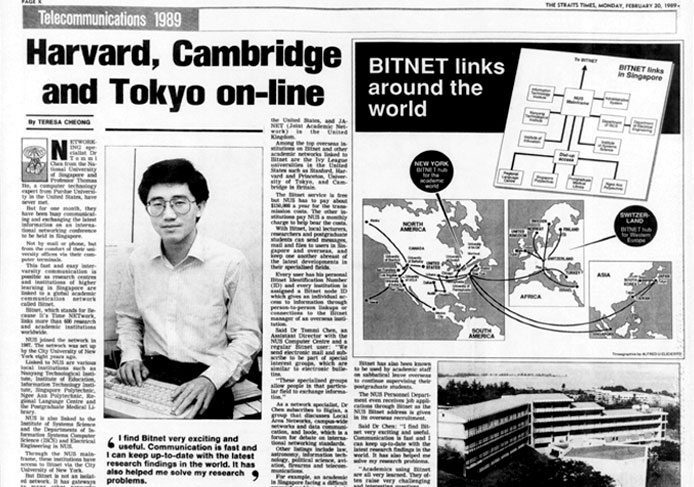1981 - The genesis: NCB and computerisation of the civil service
Singapore’s technology landscape cuts an enviable figure today. It recently became home to the world’s fastest home broadband service. The government has launched a “Smart Nation” initiative which could see public spaces here outfitted with a fleet of sensors and tap into the advanced field of data analytics. The expected outcome: Emergence of a raft of novel ways to make everyday living easier, safer and more convenient for Singaporeans.
These and other glitzy information and communications technology (ICT) achievements and plans can be traced back to 35 years ago, to a government agency that started out with the more utilitarian task of driving computerisation in Singapore’s Civil Service, but would go on to steer many crucial ICT initiatives here including the Singapore One nationwide broadband network.
The agency was the National Computer Board (NCB). It was set up in September 1981 to perform three main statutory functions: Computerise Singapore’s Civil Service, coordinate computer education and training, and develop the local computer services industry.

Its Civil Service Computerisation Programme (CSCP) targeted an initial group of 10 government ministries. The aim was to improve public administration by using IT to automate work and reduce paperwork. Over time, it evolved to include groundbreaking government e-services like TradeNet, MediNet and LawNet, that catered to the private sector.
The CSCP played a foundational role in Singapore’s ICT development. For one, it set the pace for the application of ICT in Singapore at the time. It also demonstrated the efficacy of technology usage and information sharing to organisations and businesses beyond the civil service. A cost-benefit study in 1988 showed that CSCP provided a return on investment of 171 per cent.
NCB was pivotal to the growth of Singapore’s ICT industry in the early years. In 1980, there were only 800 IT professionals working in Singapore. By 1998, there were over 33,000. Singapore’s IT industry crossed the $11 billion mark in 1997.
In 1999, NCB merged with the Telecommunication Authority of Singapore (TAS) to form the Infocomm Development Authority of Singapore (IDA).
1987 – Singapore joins global networking community
In October 1985, Professor Bernard Tan, then Dean of Science at the National University of Singapore (NUS), went to Austin in Texas to attend a conference on networking and computer issues in higher education. It was run by Educom, an organisation that founded Bitnet (which stands for “Because It’s There Network”).
A precursor to the Internet, Bitnet connected over 600 computers in academic institutions largely in the US, Canada and Europe. Members could send emails to each other and join forums and discussion groups. Convinced by what he saw, Prof Tan urged the NUS to sign up. Two years later, Singapore joined Japan and Israel as the only countries in Asia to have a Bitnet node. It marked Singapore’s entry as a key member of the budding international networking community.

1988 – The mobile phone arrives

It was 27 years ago, in August 1988, when the handheld mobile phone – or mobile phone – made its first call in Singapore. SingTel’s new cellular service was based on the Advanced Mobile Phone System (Amps), an analog mobile network technology used in countries such as the US and Hong Kong. The new service gave the Singapore public the most portable means of mobile communication yet, trumping existing carphones and bulky portaphones.
The mobile phone was a hit, with 2,200 units snapped up in the first month. Within a year, over 8,500 mobile phone sets were sold, the bulk of them mobile phones. Four models of mobile phones were initially offered, ranging from $2,900 to $3,400. A year later, mobile phone users were able to make calls in underground MRT tunnels - a first in the world.
A Straits Times article in July 1989 had then touted the mobile phone as having these features:
- An electronic lock that allows the user to use a code to electronically lock the phone
- An air-time meter which works like a stopwatch. This lets the user monitor call duration
1989 – TradeNet makes trade document processing a breeze
In the mid 1980s, processing trade permits and other documentation was a laborious paper process which was cumbersome slow. At that time, the Trade Development Board was processing 2.5 million trade documents a year and approval of permits took two to four days.
The Internet was still in its gestation but that did not stop the Trade Development Board from coming up with TradeNet - a new electronic document processing system which slashed the processing time of trade documents and hastened the speed of commerce. TradeNet slashed the cost and time for the preparation, submission and processing of documents to 15 minutes, with cost savings estimated to be at US$1 billion a year. TradeNet won the 1989 Partners in Leadership Award from the US Society of Information Management.
